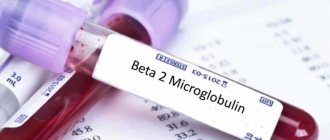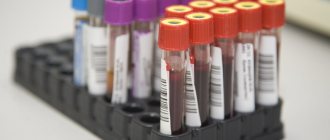Why is lupus anticoagulant dangerous?
The danger of lupus anticoagulant is that it causes antiphospholipid syndrome (APS), a condition that significantly increases the risk of blood clots.
The cause of the pathology is a failure in the immune system; one of the reasons for its occurrence may be a previous infectious-inflammatory disease. Reference! Lupus anticoagulant was so named because this substance was first discovered in patients with systemic lupus erythematosus (SLE), a severe autoimmune disease of connective tissue and small blood vessels.
Test and screening
For patients with autoimmune pathology, this analysis is the main one in determining the risk of blood clots. If a pregnant woman has a high level of an anticoagulant, this is considered a marker of the threat of miscarriage or premature birth.
For women preparing to bear a child, this test is considered mandatory if there has been thrombosis in the past or a complicated obstetric history. Such patients are at risk for miscarriage. For them, this screening test is indicated at least twice in the first months with an interval of 6 weeks.
In cardiorheumatology, analysis helps to determine the cause of rheumatic carditis and heart defects.
Indications for VA analysis
List of indications for testing for lupus anticoagulant:
- Relapses of arterial and venous thrombosis.
- Suspicion of antiphospholipid syndrome.
- Serious immune disorders (AIDS, autoimmune diseases).
- Thromboembolism (blockage of blood vessels with blood clots).
- Previous ischemic stroke.
- Moderate decrease in the number of platelets in the blood, which is combined with thrombosis.
- Prolongation of aPTT without a significant tendency to bleeding.
- Habitual miscarriage.
Tests for Lupus Anticoagulant and Abnormal Hypocoagulation in Covid-19 Patients
To prevent the causes obtained during the studies, it is recommended to prescribe anticoagulants in therapeutic and prophylactic doses.
Hypocoagulation by APTT indicates the presence of a deficiency of a blood clotting factor or inhibitor of a specific (for example, antibodies to factor VIII) or nonspecific (for example, lupus anticoagulant) nature.
Lupus anticoagulant may interfere in vitro with blood coagulation tests but is not usually associated with bleeding.
In the context of Antiphospholipid Syndrome, lupus anticoagulant is associated with thrombotic risk.
A study was conducted to determine the cause of prolonged aPTT in patients with Covid-19.
Blood samples obtained from 216 patients with Covid-19 with acute respiratory syndrome in screening tests - coagulation tests observed a prolonged aPTT clotting time for 44 (20%) patients.
Samples from 9 patients were excluded, and samples from 35 patients were examined further.
The results of this study are shown in the table:
The average age was 57 years for 24 male patients, where 1 patient was with confirmed pulmonary embolism, 1 patient with suspected thrombosis. Without pronounced clinical manifestations of bleeding or arterial thrombosis. No patients were found to have factor VIII or factor IX deficiency.
For 5 patients, a decrease in factor XI activity was observed without obvious clinical manifestations. For 16 patients, factor XII levels were 50 IU/dL or lower.
Lupus anticoagulant testing was performed on 34 patients, where 31 (91%) were positive.
The presence of Lupus anticoagulant was found for 18 of 34 (53%) patients
simultaneously in two test systems (dilute Russell's viper venom test and aPTT sensitive to Lupus anticoagulant),
1 of 7 (21%)
in the dilute Russell's viper venom test, and
1 of 6 (18%)
in the aPTT test sensitive to Lupus anticoagulant.
All positive samples with Lupus anticoagulant in the prolonged APTT test were corrected in a 50:50 mix test (patient plasma and normal plasma are mixed in a 50:50 ratio).
In a control cohort of 514 specimens tested for lupus anticoagulant, 43 (8%) had an aPTT of 30 seconds or higher, and 11 of 43 (26%) had a positive lupus anticoagulant.
The number of samples positive for lupus anticoagulant was significantly higher among Covid-19 patients than in the control cohort (P<0.001).
In this study, the majority of Covid-19 patients admitted to the hospital with a prolonged aPTT were found to have lupus anticoagulant (91%) and the presence of factor XII deficiency.
It is important to note that none of these observations were associated with the development of bleeding. Factor XII is not an active proenzyme and in the presence of a lupus anticoagulant, its persistence, thrombotic episodes may develop as a result of the antiphospholipid syndrome.
Further studies on lupus anticoagulant in the pathogenesis of thrombosis in Covid-19 patients are needed.
In these studies, we detected the effect of heparin in 28 of 35 samples, since the test with diluted Russell's viper venom contains heparinase, a neutralizer of the heparin effect, which in turn can lead to a false-positive result for the presence of lupus anticoagulant.
An association between lupus anticoagulant and acquired factor XII deficiency has been previously described as the presence of factor XII antibodies.
It was noteworthy that in these studies, high factor VIII activity was observed for patients with hypocoagulation by APTT.
It has been suggested that a prolonged aPTT is not a barrier to anticoagulant therapy for the prevention and treatment of venous thrombosis in patients with Covid-19.
It can be assumed that clinicians should not exclude anticoagulants for thrombosis until the causes of prolonged aPTT are clarified, and they should not refuse thrombolytic therapy in conditions of a high risk of developing pulmonary embolism on the basis of an isolated prolonged aPTT.
Expert opinion:
One of the causes of arterial and venous thrombosis, especially in young and middle-aged people, is the production of antibodies to phospholipids (aPL). These antibodies are a heterogeneous group of autoantibodies directed to a complex formed by a phospholipid (cardiolipin, phosphatidylserine, phosphatidylinositol, phosphatidylethanolamine, phosphatidylcholine) and a cofactor protein (most often beta2-glycoprotein I or prothrombin).
APS is a model of autoimmune thrombosis and belongs to acquired thrombophilias. This is the only therapeutic disease whose diagnosis requires mandatory laboratory confirmation.
According to the data obtained, it is recommended to use anticoagulants and thrombolytics even before determining the causes of prolonged aPTT, since there is a very high risk for patients with Covid-19 of developing thrombotic complications.
Preparing for the study
In order for the analysis result to be as reliable as possible, a number of therapeutic and diagnostic procedures should be excluded before the study:
- X-ray diagnostics;
- physiotherapeutic procedures;
- intravenous injections and drips;
- various punctures and biopsies;
- endoscopic research methods (gastro-, colonoscopy, etc.);
- electrocardiography (ECG);
- massage and palpation;
- physical exercise.
Also, in order to avoid false-positive results, before donating blood for analysis, you must stop taking heparin (2 days before the test) and coumarin drugs (warfarin, acenocoumarol, etc.).
Blood is taken for analysis in the morning, on an empty stomach.
Antiphospholipid syndrome
Lupus anticoagulant helps suppress the reaction in the blood from converting prothrombin to thrombin. These antibodies are formed in the body as a consequence of the formation of autoimmune processes after any infectious influences. More often this is one of the main signs of APS (antiphospholipid syndrome). An increase in the amount of anticoagulants in a person’s blood is perceived as a risk factor, indicating the body’s predisposition to venous and arterial thrombosis and the manifestation of an autoimmune process. Lupus anticoagulant affects hemostatic parameters, since phospholipids participate in their formation. The mechanism of its action is to neutralize phospholipids, which have a negative charge, as well as their complexes with proteins involved in blood clotting.
Decoding the research results
The lupus anticoagulant test result may be positive or negative.
A positive result has its own gradations:
- Weakly positive (1.2 - 1.5 arbitrary units) - insignificant VA activity
- Moderate (1.5 - 2 conventional units) - there is a risk of increased thrombosis.
- High (above 2 conventional units) - a significant increase in the level of immunoglobulin G in the blood and a high risk of thrombosis.
If result is negative, there is no lupus coagulant in the blood.
Also, the research result can be measured in seconds. In this case, the normal indicator will be 31 - 44 s.
The main reasons for the appearance of lupus anticoagulant in the blood
Most often, VA appears in the following autoimmune diseases:
- SLE (systemic lupus erythematosus);
- APS (antiphospholipid syndrome);
- multiple myeloma;
- cancer;
- nonspecific ulcerative colitis (Crohn's disease);
- rheumatoid arthritis.
Also, lupus anticoagulant can appear in the blood due to taking certain medications, for example phenothiazine, quinine, estrogen-containing drugs, valproic acid.
In any case, the test result is not a diagnosis. A positive result requires repeated texts and additional diagnostics.
At the EC-Clinic, results are interpreted by experienced specialists with extensive clinical experience, which makes it possible to establish an accurate diagnosis and prescribe effective treatment for the identified pathology.
Symptoms
Signs of high lupus anticoagulant in the blood manifest differently in each person, depending on the individual characteristics of the body.
Most often, patients complain of the following abnormalities:
- the appearance of spider veins (capillaries can appear on absolutely any part of the body, right up to the face);
- the appearance of small ulcers on the epidermis;
- tissue death at the fingertips;
- damage to heart valves (deformation, stretching);
- cirrhosis of the liver (develops only if the vessels are affected by more than 50%);
- Alzheimer's disease (also appears in severe forms of the pathology).
As medical practice shows, in women the manifestation of symptoms is more pronounced, and the signs can become noticeable already at a young age.






